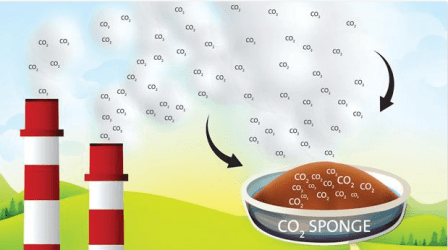Researchers Develop A New Sponge-like Carbon Dioxide Adsorbent
Researchers across the globe are working to find alternative and efficient ways to tackle the issue of pollution. The major air pollutant carbon dioxide (CO2) is the primary cause of global warming. With an intension to impact the presence of CO2 in air and improve the quality of air, a team of scientists has developed a new sponge-like material that can mop up the greenhouse gas. This brown, sand-like powdery polymer is prepared by linking together many small carbon-based molecules into a network that is able to hold large amounts of CO2 under pressure. One of the main advantages of using this polymer is that it tends to be very stable. Apart from that, it is inexpensive, robust, adsorbs CO2 extremely well and is tolerant to acidic impurities and water vapor.

There are already many carbon dioxide adsorbents that routinely remove air pollutants from chimney stacks of power plants where fossil fuels are burned. But, this novel, micro porous polymer adsorbent can be embedded easily in the smokestacks at power plants and it could work towards the zero-emission and emerging technology called an integrated gasification combined cycle (IGCC).The IGCC technology converts fossil fuels into hydrogen gas and CO2, which must be separated. But, according to the scientists, this process could be used for the generation of energy that will almost produce no pollution. Cooper, who is at the University of Liverpool, said that the adsorbent is swelled slightly when the CO2 is adsorbed by it and when the pressure is dropped the CO2 is released from the polymer. The released CO2 is then accumulated for storage or converted into useful compounds of carbon.
The research titled #-Link-Snipped-# is published in American Chemical Society (ACS) Journal and will be presented at 248th National Meeting & Exposition of the American Chemical Society.
Source: #-Link-Snipped-#
There are already many carbon dioxide adsorbents that routinely remove air pollutants from chimney stacks of power plants where fossil fuels are burned. But, this novel, micro porous polymer adsorbent can be embedded easily in the smokestacks at power plants and it could work towards the zero-emission and emerging technology called an integrated gasification combined cycle (IGCC).The IGCC technology converts fossil fuels into hydrogen gas and CO2, which must be separated. But, according to the scientists, this process could be used for the generation of energy that will almost produce no pollution. Cooper, who is at the University of Liverpool, said that the adsorbent is swelled slightly when the CO2 is adsorbed by it and when the pressure is dropped the CO2 is released from the polymer. The released CO2 is then accumulated for storage or converted into useful compounds of carbon.
The research titled #-Link-Snipped-# is published in American Chemical Society (ACS) Journal and will be presented at 248th National Meeting & Exposition of the American Chemical Society.
Source: #-Link-Snipped-#
0
